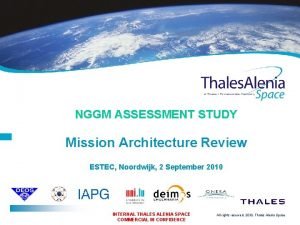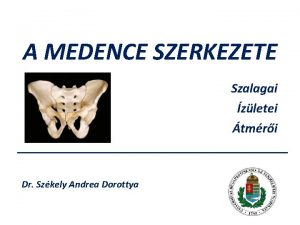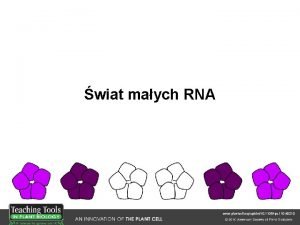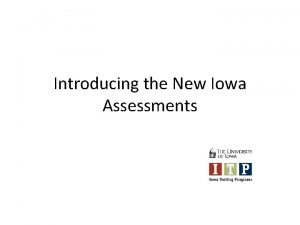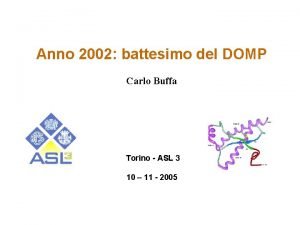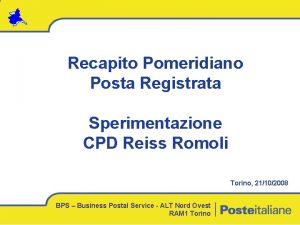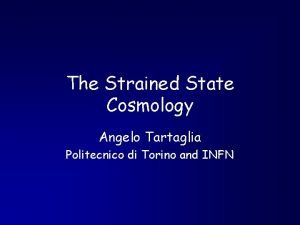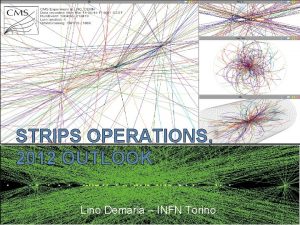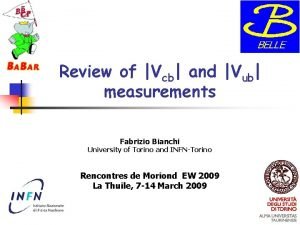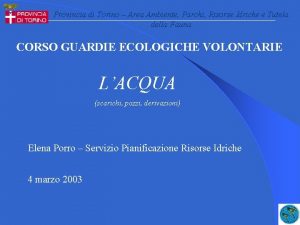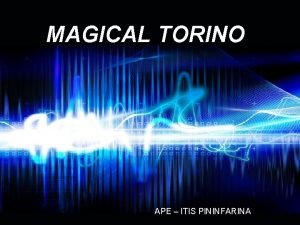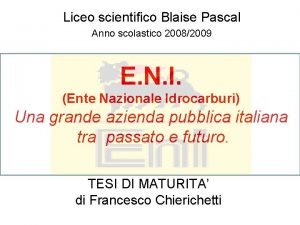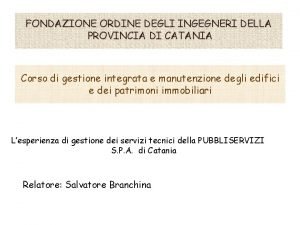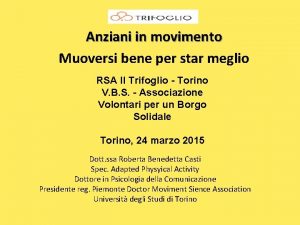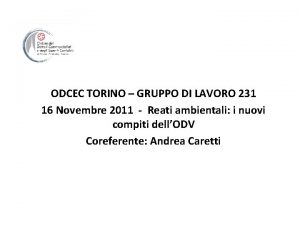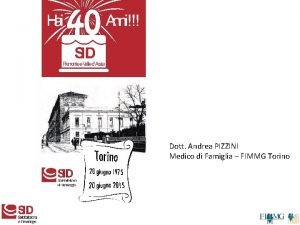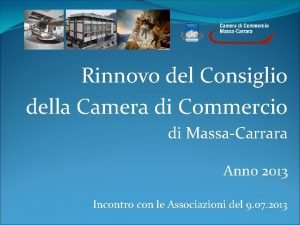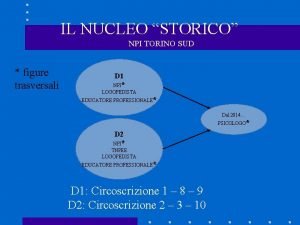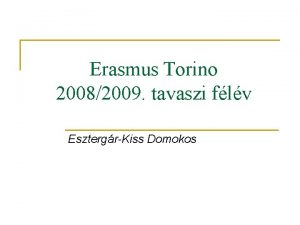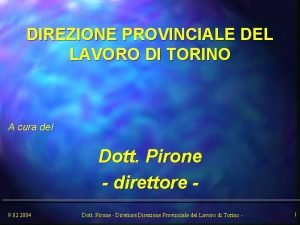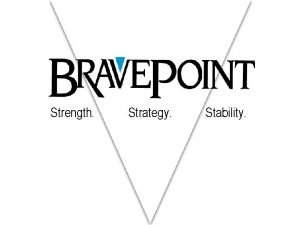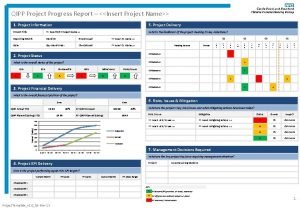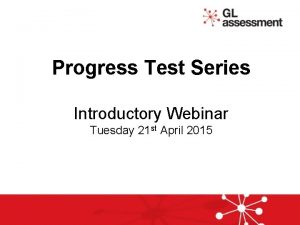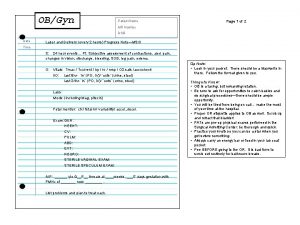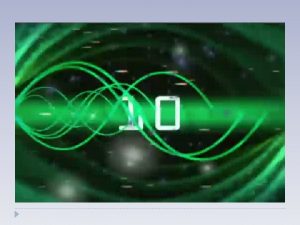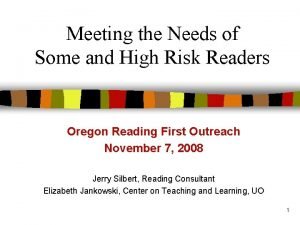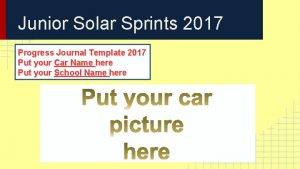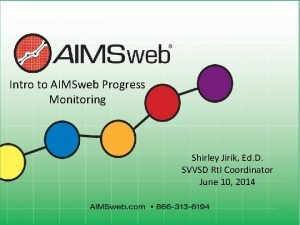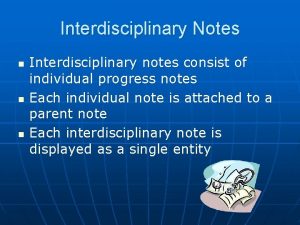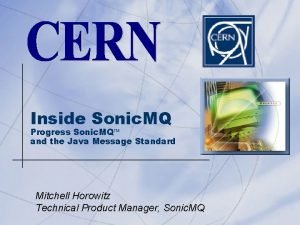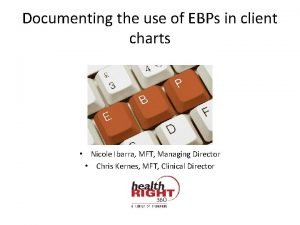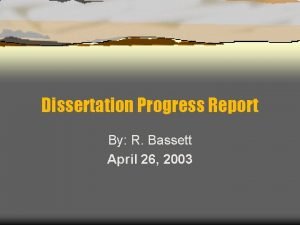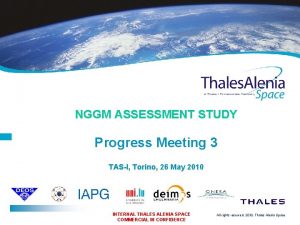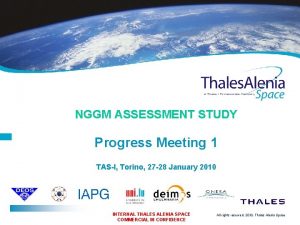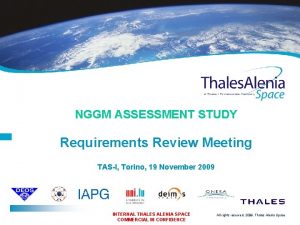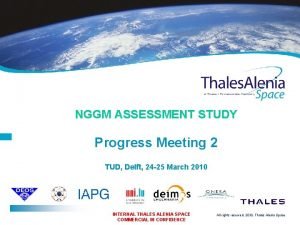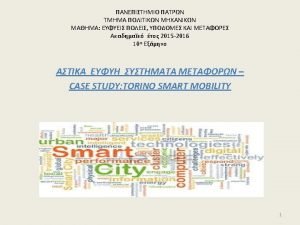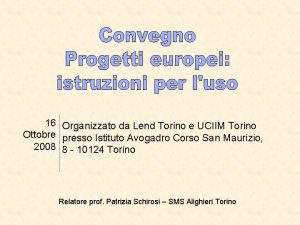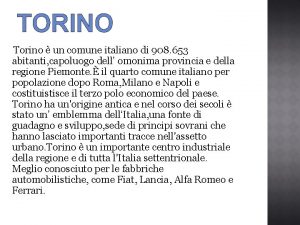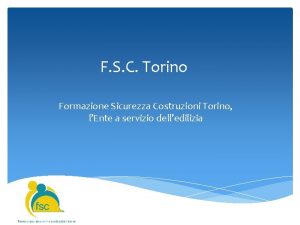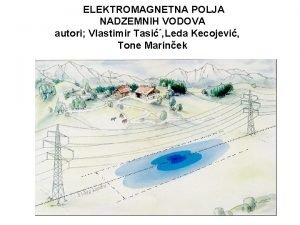NGGM ASSESSMENT STUDY Progress Meeting 3 TASI Torino






![Laser metrology performance requirements Page 7 Interferometer measurement noise requirement [m/ Hz] 10 nm/ Laser metrology performance requirements Page 7 Interferometer measurement noise requirement [m/ Hz] 10 nm/](https://slidetodoc.com/presentation_image_h/18ed64a4500b2982406890674136fe6b/image-7.jpg)





































































































- Slides: 108

NGGM ASSESSMENT STUDY Progress Meeting 3 TAS-I, Torino, 26 May 2010 INTERNAL THALES ALENIA SPACE COMMERCIAL IN CONFIDENCE All rights reserved, 2010, Thales Alenia Space

Agenda Page 2 9. 15 9. 30 11. 00 12. 00 13. 30 14. 30 16. 15 16. 30 Introduction and Agenda Task 2: Observing techniques WP 2120 Instrument Concepts TAS-I WP 2121 Measurement Technologies ONERA WP 2110 Observing Techniques DEOS [IAPG] Task 3: Mission analysis and attitude and orbit control concepts WP 2220 Attitude and Orbit Control Concepts TAS-I WP 2210 Mission Analysis TAS-I [DEIMOS] Task 5: Mission Architecture Outlines WP 2420: Mission Architecture DEOS [GIS] WP 2410: Architecture Definition and Trade-Off TAS-I Lunch break Task 4: Simulation Tool WP 2310 End-to-End Simulator Design and Implementation TAS-I WP 2320 Variable Gravity Model DEOS [IAPG] WP 2330 Backward Module DEOS Discussion, Planning Adjourn NGGM Assessment Study 26 May 2010 INTERNAL THALES ALENIA SPACE COMMERCIAL IN CONFIDENCE All rights reserved, 2010, Thales Alenia Space

Page 3 WP 2120 Instrument Concepts (TAS-I) NGGM Assessment Study 26 May 2010 INTERNAL THALES ALENIA SPACE COMMERCIAL IN CONFIDENCE All rights reserved, 2010, Thales Alenia Space

Top-level requirements Page 4 From science requirements to measurement requirements Geoid cumulative error 1 mm at SH 200, 10 mm at SH 250 is achievable with: q orbit altitude = 300 km q satellite-satellite distance = 100 km q satellite-to-satellite distance variation relative error SD 2 10 -13 1/ Hz -11 m/s 2/ Hz q non-gravitational acceleration measurement error SD 10 NGGM Assessment Study 26 May 2010 INTERNAL THALES ALENIA SPACE COMMERCIAL IN CONFIDENCE All rights reserved, 2010, Thales Alenia Space

Satellite-Satellite distance error tree Page 5 Satellite-to-satellite distance measurement error SD 20 nm/ Hz relative error 2 10 -13 1/ Hz at satellite-to-satellite distance d = 100 km. Error breakdown (for the metrology without BSM) defined to relax as far as possible the requirements on laser beam frequency stability and pointing (satellite relative orientation). NGGM Assessment Study 26 May 2010 INTERNAL THALES ALENIA SPACE COMMERCIAL IN CONFIDENCE All rights reserved, 2010, Thales Alenia Space

Laser frequency stability Page 6 Relative stability for d = 100 km Measurement error if laser frequency stability = 300 Hz/ Hz (10 x LISA): 107. 5 nm/ Hz (relative error = 1. 075 10 -12 1/ Hz at d = 100 km) NGGM Assessment Study 26 May 2010 INTERNAL THALES ALENIA SPACE COMMERCIAL IN CONFIDENCE All rights reserved, 2010, Thales Alenia Space
![Laser metrology performance requirements Page 7 Interferometer measurement noise requirement m Hz 10 nm Laser metrology performance requirements Page 7 Interferometer measurement noise requirement [m/ Hz] 10 nm/](https://slidetodoc.com/presentation_image_h/18ed64a4500b2982406890674136fe6b/image-7.jpg)
Laser metrology performance requirements Page 7 Interferometer measurement noise requirement [m/ Hz] 10 nm/ Hz Measurement noise of the Satellite 2 (Satellite 1) orientation to S-S line, provided by the angle (lateral) metrology on Satellite 2 2 µrad/ Hz Optical power on the interferometer sensor (pd 2) required for 10 nm/ Hz =0. 8 p. W OK from link budget. Optical power on the PSD of the angle metrology on S 2 for 2 µrad/ Hz = 70 n. W OK from link budget NGGM Assessment Study 26 May 2010 INTERNAL THALES ALENIA SPACE COMMERCIAL IN CONFIDENCE All rights reserved, 2010, Thales Alenia Space

Reference accelerometer layout choice Z Page 8 US axis LS axis Y X Concept 1 Concept 2 Concept 3 Concept 4 Concept 1: excluded since it doesn’t provide any GGT component measurement. Concept 2: excluded since it doesn’t measure the linear acceleration along each direction with accelerometer US axes (the linear acceleration Z is measured with LS axes only). Both Concept 3 and 4 provides the VYY and VZZ components of the GGT and measures two angular accelerations with US axes. Concept 3 is preferred to Concept 4 because the linear acceleration along X (nominally aligned to the satellite-to-satellite line) is measured with four US axes (two in the Concept 4). Warning: due to the lack of accelerometers along X, the measurement of the Y, Z angular accelerations is unavoidably contaminated by the off-diagonal GGT components VXZ, VXY. NGGM Assessment Study 26 May 2010 INTERNAL THALES ALENIA SPACE COMMERCIAL IN CONFIDENCE All rights reserved, 2010, Thales Alenia Space

Reference accelerometer layout choice Page 9 Linear acceleration X: a. X = (a 1 X + a 2 X + a 3 X + a 4 X)/4 (US axes only) Linear acceleration Y, Z: a. Y = (a 1 Y + a 3 Y)/2 , a. Z = (a 2 Z + a 4 Z)/2 (US axes only) Angular acceleration X: d X/dt = [(a 1 Z – a 3 Z)/L – (a 2 Y – a 4 Y)/L]/2 (LS axes only) Angular acceleration Y: d Y/dt = (a 2 X – a 4 X)/L + VXZ - X Z (US axes only) Angular acceleration Z: d Z/dt = (a 3 X – a 1 X)/L - VXY + X Y (US axes only) GGT components: VYY = (a 3 Y – a 1 Y)/L - X 2 - Z 2; VZZ = (a 4 Z – a 2 Z)/L - X 2 - Y 2 NGGM Assessment Study 26 May 2010 INTERNAL THALES ALENIA SPACE COMMERCIAL IN CONFIDENCE All rights reserved, 2010, Thales Alenia Space

Acceleration measurement error tree Error breakdown updated for the 4 -accelerometer reference layout and defined to match the satellite pointing requirements with those from the S-S distance measurement NGGM Assessment Study 26 May 2010 Page 10 10 -11 m/s 2/ Hz INTERNAL THALES ALENIA SPACE COMMERCIAL IN CONFIDENCE All rights reserved, 2010, Thales Alenia Space

Accelerometer performance requirements Page 11 Requirements applicable to the 4 -accelerometer reference layout. q Accelerometer noise: 3 10 -12 m/s 2 Hz (US axes) q Accelerometer noise: 3 10 -10 m/s 2 Hz (LS axis) q Accelerometer bias: 2 10 -7 m/s 2 (all axes) q Common and differential scale factors knowledge: 2 10 -4 for X axis (from calibration): 1 10 -3 for Y, Z axes (from calibration) The requirement of the common SF is more stringent than in GOCE (2 10 -3) where the differential accelerations and not the common-mode ones are the main observables. q Accelerometer scale factor stability (all): 10 -6 1 Hz ll-SST GGT Note: for the ll-SST purposes, it is not required for the accelerometer noise to be flat till 0. 1 Hz, since the metrology measurement error is dominant above 0. 01 Hz. However, a low noise level till 0. 1 Hz (achievable with the GOCE accelerometers) can be useful for the GGT components measurements. NGGM Assessment Study 26 May 2010 INTERNAL THALES ALENIA SPACE COMMERCIAL IN CONFIDENCE All rights reserved, 2010, Thales Alenia Space

Derived control requirements Page 12 q Satellite X-axis alignment to the satellite-to-satellite direction: Satellite 2: 1 (thanks to the use of a retro-reflector) Satellite 1: 2 10 -5 rad (driven by the laser beam pointing) q Satellite X-axis pointing stability relative to the satellite-to-satellite direction (Merging of the needs of the satellite-to-satellite distance measurement and of the nongravitational acceleration measurement): 10 µrad/ Hz Driven by the laser beam pointing 2 µrad/ Hz NGGM Assessment Study 26 May 2010 INTERNAL THALES ALENIA SPACE COMMERCIAL IN CONFIDENCE All rights reserved, 2010, Thales Alenia Space

Derived control requirements Page 13 Linear acceleration control (drag-free level) of each satellite along each axis. 10 -8 m/s 2/ Hz Angular acceleration and angular rate control of each satellite about each axis. 10 -6 rad/s/ Hz Formation control: q 10% on the relative distance q 5 10 -3 d along transversal directions NGGM Assessment Study 26 May 2010 INTERNAL THALES ALENIA SPACE COMMERCIAL IN CONFIDENCE 10 -8 rad/s 2/ Hz All rights reserved, 2010, Thales Alenia Space

Laser metrology budgets Page 14 NGGM Assessment Study 26 May 2010 INTERNAL THALES ALENIA SPACE COMMERCIAL IN CONFIDENCE All rights reserved, 2010, Thales Alenia Space

Page 15 WP 2121 Measurement Technologies (ONERA) NGGM Assessment Study 26 May 2010 INTERNAL THALES ALENIA SPACE COMMERCIAL IN CONFIDENCE All rights reserved, 2010, Thales Alenia Space

Input for accelerometer technology review (1/1) Concept 3 Page 16 ACC 2 Linear acceleration Cross-track axis Y Radial axis Z ACC 3 Sat-Sat axis, X ACC 1 Scale factor stability Sat-Sat axis, X Cross-track axis Y Radial axis Z ACC 4 Linear acceleration bias Bias along Y < 2 10 -7 m/s 2 Bias along Z < 2 10 -7 m/s 2 NGGM Assessment Study 26 May 2010 INTERNAL THALES ALENIA SPACE COMMERCIAL IN CONFIDENCE All rights reserved, 2010, Thales Alenia Space

Input for accelerometer technology review (2/2) Page 17 ACC 2 Angular acceleration ACC 3 ACC 1 Angular acceleration around X: • from a. Z 1 – a. Z 3 et a. Y 2 – a. Y 4, Angular acceleration around Y: • from a. X 2 – a. X 4 , Angular acceleration around Z: • from a. X 1 – a. X 3 NGGM Assessment Study 26 May 2010 ACC 4 INTERNAL THALES ALENIA SPACE COMMERCIAL IN CONFIDENCE All rights reserved, 2010, Thales Alenia Space

Proposed concept of accelerometer Page 18 Short-term solution with TRL 9 with levitation on-ground GOCE/GRACE concept • 2 ultra-sensitive axes • 1 less-sensitive axis • 1 angular acceleration measure • Analogic or Digital control loop g X Z Y NGGM Assessment Study 26 May 2010 INTERNAL THALES ALENIA SPACE COMMERCIAL IN CONFIDENCE All rights reserved, 2010, Thales Alenia Space

Improved GOCE solution Linear Acceleration Improvement wrt GOCE: • Temperature stability NGGM Assessment Study 26 May 2010 Page 19 With 4 accelerometers: • a. X given by ¼(a. X 1+a. X 2+a. X 3+a. X 4) • a. Y given by ½(a. Y 1+a. Y 3) • a. Z given by ½(a. Z 2+a. Z 4) INTERNAL THALES ALENIA SPACE COMMERCIAL IN CONFIDENCE All rights reserved, 2010, Thales Alenia Space

Improved GOCE solution Angular Acceleration Page 20 X Z Y From linear accelerations in spacecraft reference frame NGGM Assessment Study 26 May 2010 From angular accelerations in accelerometer reference frame INTERNAL THALES ALENIA SPACE COMMERCIAL IN CONFIDENCE in S/C ref. frame All rights reserved, 2010, Thales Alenia Space

Improved GOCE solution Page 21 From Angular acceleration From Linear acceleration Angular Acceleration Limitation LS axis: • Detector noise (limited by range = ± 6 µm) • Contact Potential Difference • Gold wire damping NGGM Assessment Study 26 May 2010 INTERNAL THALES ALENIA SPACE COMMERCIAL IN CONFIDENCE All rights reserved, 2010, Thales Alenia Space

Improved GOCE solution Page 22 Scale factor Temperature stability Mechanical Temperature driven by accelerometer noise Tmec = 40 m. K/Hz 1/2 (1 m. Hz / f) Grad Tmec = 4 m. K/Hz 1/2 (1 m. Hz / f) Electronic Temperature driven by scale factor stability Telec = 40 m. K/Hz 1/2 (1 m. Hz / f) Range Control range Measurement range 3. 1 10 -5 m/s 2 6. 4 10 -6 m/s 2 Bias Improvement wrt GOCE: • Reference voltage of ADC 2 NGGM Assessment Study 26 May 2010 Along Y (ACC 1, 3) Along Z (ACC 2, 4) INTERNAL THALES ALENIA SPACE COMMERCIAL IN CONFIDENCE 1. 2 10 -7 m/s 2 All rights reserved, 2010, Thales Alenia Space

New concept for angular acceleration Page 23 Cubic proof-mass for having 3 angular accelerations: - Proof-mass in Pt. Rh 10: 25 x 25 mm 3, 0. 315 kg - no more testable on ground - one linear & one angular freedom controlled by axis Other design 55 mm (GOCE 70 mm) X Y Other design Z Additional studies are necessary NGGM Assessment Study 26 May 2010 INTERNAL THALES ALENIA SPACE COMMERCIAL IN CONFIDENCE All rights reserved, 2010, Thales Alenia Space

Improved GOCE solution Mass and power budget Analogic control loop (GRACE) Digital control loop (GOCE) Advantages - Consumption - Size (FEEU electronic around ASH) Advantages - Detector/action redundancy - K 2 correction easy Mass ASH with FEEU : 7. 6 kg x 4 => 30. 4 kg ICU* 3. 7 kg x 4 => 14. 8 kg 45. 2 kg Mass ASH FEEU GAIEU Consumption ASH with FEEU : 2. 1 W x 4 => 8. 4 W ICU* 7. 1 W x 4 => 28. 4 W 36. 8 W * Could be reduced NGGM Assessment Study 26 May 2010 Page 24 5. 2 kg x 4 => 20. 8 kg 6. 3 kg x 2 => 12. 6 kg 6. 6 kg x 1 => 6. 6 kg 40. 0 kg Consumption FEEU 15 W x 2 => 30 W GAIEU 16. 5 W x 1 => 33 W 63 W INTERNAL THALES ALENIA SPACE COMMERCIAL IN CONFIDENCE All rights reserved, 2010, Thales Alenia Space

Page 25 WP 2220 Attitude and Orbit Control Concepts (TAS-I) NGGM Assessment Study 26 May 2010 INTERNAL THALES ALENIA SPACE COMMERCIAL IN CONFIDENCE All rights reserved, 2010, Thales Alenia Space

Activities since PM 2 Page 26 Performed activities since PM 2 and presentation content. q Answer to the PM 2 TAS-I AI#1 : to identify the main effects driving the formation control. q Improvement of the formation flying control algorithm to reduce the init transient time. q Preliminary results of the algorithms to track Sat 2 by Sat 1 (in-line and pendulum geometries). q Support for system level analysis (e. g. fuel budget, presented elsewhere) and integration of the control laws in E 2 E simulator. NGGM Assessment Study 26 May 2010 INTERNAL THALES ALENIA SPACE COMMERCIAL IN CONFIDENCE All rights reserved, 2010, Thales Alenia Space

Answer to the TAS-I AI#1 Page 27 Answer to the TAS-I AI#1 (1/6) AI#1: TAS-I to identify the main effects driving the formation control (are the causes of cross-track, radial bias driven by the spacecraft systems or by natural perturbations? ) Pictures from PM 2 NGGM Assessment Study 26 May 2010 INTERNAL THALES ALENIA SPACE COMMERCIAL IN CONFIDENCE All rights reserved, 2010, Thales Alenia Space

Answer to the TAS-I AI#1 Page 28 Answer to the TAS-I AI#1 (2/6) q The main effects driving the formation control performances are differential linear accelerometers biases. In particular, the worst effect come from the Xaxis (along track) differential linear acceleration. This has been already addressed by Deimos at PM 2. New results from E 2 E simulator will be presented hereafter. q These effects have been considered driver for algorithm design phase. q Taking into account the very low-control bandwidth that shall be considered formation flying control design to do not corrupt to much the differential gravity acceleration, the Clohessy-Wiltshire equation in Hill reference frame are good enough to address the effects of differential bias on formation. NGGM Assessment Study 26 May 2010 INTERNAL THALES ALENIA SPACE COMMERCIAL IN CONFIDENCE All rights reserved, 2010, Thales Alenia Space

Answer to the TAS-I AI#1 Page 29 Answer to the TAS-I AI#1 (3/6) q CWH model puts in evidence coupling between XZ axes (along-track/ radial), Y axis (across track) is uncoupled. Since the model is linear, the superposition principle may be applied. q If we apply a bias on X linear axis (along-track) only, then: q X-axis relative position grows in quadratic way; q Z-axis relative position grows in linear way. q If we apply a bias on Z linear axis (radial) only, then: q X-axis relative position grows in linear way; q Z-axis relative position remains bounded with an amplitude related to the applied bias. q If we apply a bias on Y linear axis (across-track) only, then: q Y-axis relative position remains bounded with an amplitude related to the applied bias. NGGM Assessment Study 26 May 2010 INTERNAL THALES ALENIA SPACE COMMERCIAL IN CONFIDENCE All rights reserved, 2010, Thales Alenia Space

Answer to the TAS-I AI#1 Page 30 Answer to the TAS-I AI#1 (4/6) q As consequence of previous statements, the proposed formation control for the observation phase may be very simple. q The along track (X-axis) relative position shall be controlled. The controller shall embed the capability to estimate the differential bias and shall provide compensation for it (i. e. PID like controller). q Radial (Z-axis) and across-track (Y-axis) may be left without any specific control law. The observed formation drift is still compatible with the requirement up to 60 or more days mission. q The observation phase shall be preceded and followed by formation acquisition phases (based for instance on already available control algorithms developed during the previous study phases). NGGM Assessment Study 26 May 2010 INTERNAL THALES ALENIA SPACE COMMERCIAL IN CONFIDENCE All rights reserved, 2010, Thales Alenia Space

Answer to the TAS-I AI#1 Page 31 Answer to the TAS-I AI#1 (5/6) No bias applied Differential bias X-axis 2 e-7 m/s 2 About 12 days simulation time NGGM Assessment Study 26 May 2010 INTERNAL THALES ALENIA SPACE COMMERCIAL IN CONFIDENCE All rights reserved, 2010, Thales Alenia Space

Answer to the TAS-I AI#1 Page 32 Answer to the TAS-I AI#1 (6/6) Differential bias X-axis 2 e-7 m/s 2 About 12 days simulation time NGGM Assessment Study 26 May 2010 INTERNAL THALES ALENIA SPACE COMMERCIAL IN CONFIDENCE All rights reserved, 2010, Thales Alenia Space

FF algorithm update Page 33 Results for in-line formation (1/4) Satellites’ relative position (PM 2 result) NGGM Assessment Study 26 May 2010 Satellites’ relative position (now) INTERNAL THALES ALENIA SPACE COMMERCIAL IN CONFIDENCE All rights reserved, 2010, Thales Alenia Space

FF algorithm update Page 34 Results for in-line formation (2/4) Relative position (X-axis) NGGM Assessment Study 26 May 2010 Sat 1 linear acceleration INTERNAL THALES ALENIA SPACE COMMERCIAL IN CONFIDENCE All rights reserved, 2010, Thales Alenia Space

FF algorithm update Page 35 Results for in-line formation (3/4) Relative position (X-axis) NGGM Assessment Study 26 May 2010 Relative position (YZ-axes) INTERNAL THALES ALENIA SPACE COMMERCIAL IN CONFIDENCE All rights reserved, 2010, Thales Alenia Space

FF algorithm update Page 36 Results for in-line formation (4/4) Sat 1 linear acceleration NGGM Assessment Study 26 May 2010 INTERNAL THALES ALENIA SPACE COMMERCIAL IN CONFIDENCE All rights reserved, 2010, Thales Alenia Space

Laser beam steered by attitude control Page 37 Sat 2 tracked by Sat 1 (1/9) q Preliminary algorithms have been designed to implement the Sat 2 tracking by Sat 1 attitude control. The objective is to eliminate the Beam Steering Mechanism. q They have been designed considering the following attitude control objectives: q Satellite 1 q X-axis to null the laser beam mispointing (n. P unit vector associated to the relative position Sat 2 -Sat 1); q Y-axis normal to the plane constituted by ZLORF and n. P q Z-axis in the remaining direction of the right hand orthogonal triad q Satellite 2 q LORF tracking q As expected, good results have been obtained for in-line formation. In the pendulum-case, the low-frequency angular accelerations are very high. NGGM Assessment Study 26 May 2010 INTERNAL THALES ALENIA SPACE COMMERCIAL IN CONFIDENCE All rights reserved, 2010, Thales Alenia Space

Laser beam steered by attitude control Page 38 Sat 2 tracked by Sat 1 (2/9) – In- line formation results Angular acceleration Sat 1 NGGM Assessment Study 26 May 2010 Angular acceleration Sat 2 INTERNAL THALES ALENIA SPACE COMMERCIAL IN CONFIDENCE All rights reserved, 2010, Thales Alenia Space

Laser beam steered by attitude control Page 39 Sat 2 tracked by Sat 1 (3/9) – In- line formation results Linear acceleration Sat 1 NGGM Assessment Study 26 May 2010 Linear acceleration Sat 2 INTERNAL THALES ALENIA SPACE COMMERCIAL IN CONFIDENCE All rights reserved, 2010, Thales Alenia Space

Laser beam steered by attitude control Page 40 Sat 2 tracked by Sat 1 (4/9) – In- line formation results Relative position - Sat 1 ref. frame NGGM Assessment Study 26 May 2010 Relative position – Sat 1 ref. frame - zoom INTERNAL THALES ALENIA SPACE COMMERCIAL IN CONFIDENCE All rights reserved, 2010, Thales Alenia Space

Laser beam steered by attitude control Page 41 Sat 2 tracked by Sat 1 (5/9) – In- line formation results Relative position – Sat 2 ref. frame NGGM Assessment Study 26 May 2010 Relative position – Sat 2 ref. frame - zoom INTERNAL THALES ALENIA SPACE COMMERCIAL IN CONFIDENCE All rights reserved, 2010, Thales Alenia Space

Laser beam steered by attitude control Page 42 Sat 2 tracked by Sat 1 (6/9) – Pendulum formation results Angular acceleration Sat 1 NGGM Assessment Study 26 May 2010 Angular acceleration Sat 2 INTERNAL THALES ALENIA SPACE COMMERCIAL IN CONFIDENCE All rights reserved, 2010, Thales Alenia Space

Laser beam steered by attitude control Page 43 Sat 2 tracked by Sat 1 (7/9) – Pendulum formation results Linear acceleration Sat 1 Linear acceleration Sat 2 Y-axis linear acceleration control on Sat 1 shall be modified in-order to increase the provided rejection. NGGM Assessment Study 26 May 2010 INTERNAL THALES ALENIA SPACE COMMERCIAL IN CONFIDENCE All rights reserved, 2010, Thales Alenia Space

Laser beam steered by attitude control Page 44 Sat 2 tracked by Sat 1 (8/9) – Pendulum formation results Relative position – Sat 1 ref. frame NGGM Assessment Study 26 May 2010 Relative position – Sat 1 ref. frame - zoom INTERNAL THALES ALENIA SPACE COMMERCIAL IN CONFIDENCE All rights reserved, 2010, Thales Alenia Space

Laser beam steered by attitude control Page 45 Sat 2 tracked by Sat 1 (9/9) – Pendulum formation results Relative position – Sat 2 ref. frame NGGM Assessment Study 26 May 2010 Relative position – Sat 2 ref. frame - zoom INTERNAL THALES ALENIA SPACE COMMERCIAL IN CONFIDENCE All rights reserved, 2010, Thales Alenia Space

Activities from now to MAR Page 46 Activities from PM 2 to Mission Architecture Review q Consolidation of the algorithms for the tracking of Sat 2 by Sat 1. q Definition of the actuators requirements for in-line and pendulum formations. q Definition of the star-trackers mounting architecture and accuracy. q Preparation of the TN 4: “Candidate scenarios and AOCS concepts”. q Support for system level analysis. NGGM Assessment Study 26 May 2010 INTERNAL THALES ALENIA SPACE COMMERCIAL IN CONFIDENCE All rights reserved, 2010, Thales Alenia Space

Page 47 WP 2210 Mission Analysis (DEIMOS, presented by TAS-I) NGGM Assessment Study 26 May 2010 INTERNAL THALES ALENIA SPACE COMMERCIAL IN CONFIDENCE All rights reserved, 2010, Thales Alenia Space

MA Activities since PM 2 Page 48 Atmospheric Density and Drag Study of Jacchia-Bowman new atmospheric model Spectral analysis Drag levels for polar orbits, function of LT and date Assessment of differential drag for Pendulum and In-line formations Formation Flying Stability Cartwheel formation 1 -month open-loop simulations Gravity only Gravity + 3 rd bodies + thruster bias 2 cases: Worst case: sat-2 -sat line vertical over the Equator Best case: sat-2 -sat line vertical over the Poles NGGM Assessment Study 26 May 2010 INTERNAL THALES ALENIA SPACE COMMERCIAL IN CONFIDENCE All rights reserved, 2010, Thales Alenia Space

Atmospheric Density Page 49 Jacchia-Bowman 2006 Model (JB 2006) Required by ECSS-E-ST-10 -04 C (Nov. 2008) Better and more accurate mean total atmospheric density Valid for altitudes over 120 km Key novel features: New formulation of semi-annual density variation in thermosphere New formulation of solar indices Indices: F 10. 7 : radio energy flux S 10. 7: EUV radiation M 10. 7: MUV radiation Ap NGGM Assessment Study 26 May 2010 INTERNAL THALES ALENIA SPACE COMMERCIAL IN CONFIDENCE Example: density Winter, 10: 00 UTC Sun All rights reserved, 2010, Thales Alenia Space

Atmospheric Density Page 50 Influence of Orbital Parameters on Drag Assumptions Altitude: 250 km Fixed values of the solar/geomagnetic indices Example: density Winter, 10: 00 UTC → Study the influence of other parameters Date / inclination: light influence Sun NGGM Assessment Study 26 May 2010 INTERNAL THALES ALENIA SPACE COMMERCIAL IN CONFIDENCE All rights reserved, 2010, Thales Alenia Space

Atmospheric Density Page 51 Influence of Orbital Parameters on Drag Assumptions Altitude: 250 km Fixed values of the solar/geomagnetic indices Example: density Equinox, 10: 00 UTC → Study the influence of other parameters Date / inclination: light influence Sun NGGM Assessment Study 26 May 2010 INTERNAL THALES ALENIA SPACE COMMERCIAL IN CONFIDENCE All rights reserved, 2010, Thales Alenia Space

Atmospheric Density Page 52 Influence of Orbital Parameters on Drag Assumptions Altitude: 250 km Fixed values of the solar/geomagnetic indices Example: density Summer, 10: 00 UTC → Study the influence of other parameters Date / inclination: light influence Sun NGGM Assessment Study 26 May 2010 INTERNAL THALES ALENIA SPACE COMMERCIAL IN CONFIDENCE All rights reserved, 2010, Thales Alenia Space

Atmospheric Density Page 53 Influence of Orbital Parameters on Drag Assumptions Altitude: 250 km Fixed values of the solar/geomagnetic indices Example: density Equinox, 12: 00 UTC → Study the influence of other parameters Date / inclination: light influence LTAN: strong influence LTAN 08: 00 LTAN 14: 00 Sun NGGM Assessment Study 26 May 2010 INTERNAL THALES ALENIA SPACE COMMERCIAL IN CONFIDENCE All rights reserved, 2010, Thales Alenia Space

Atmospheric Density Page 54 Influence of Orbital Parameters on Drag Assumptions Altitude: 250 km Fixed values of the solar/geomagnetic indices Example: density Equinox, 10: 00 UTC → Study the influence of other parameters Date / inclination: light influence LTAN: strong influence Altitude profile : strong influence Constant altitude 250 km Sun NGGM Assessment Study 26 May 2010 INTERNAL THALES ALENIA SPACE COMMERCIAL IN CONFIDENCE All rights reserved, 2010, Thales Alenia Space

Atmospheric Density Page 55 Influence of Orbital Parameters on Drag Assumptions Altitude: 250 km Fixed values of the solar/geomagnetic indices Example: density Equinox, 10: 00 UTC → Study the influence of other parameters Date / inclination: light influence LTAN: strong influence Altitude profile : strong influence Circular orbit sma – Eq. radius = 250 km Sun Altitude vs. Latitude NGGM Assessment Study 26 May 2010 INTERNAL THALES ALENIA SPACE COMMERCIAL IN CONFIDENCE All rights reserved, 2010, Thales Alenia Space

Atmospheric Density Page 56 Influence of Orbital Parameters on Drag Assumptions Altitude: 250 km Fixed values of the solar/geomagnetic indices Example: density Equinox, 10: 00 UTC → Study the influence of other parameters Date / inclination: light influence LTAN: strong influence Altitude profile : strong influence Frozen orbit sma – Eq. radius = 250 km Sun Altitude vs. Latitude NGGM Assessment Study 26 May 2010 INTERNAL THALES ALENIA SPACE COMMERCIAL IN CONFIDENCE All rights reserved, 2010, Thales Alenia Space

Atmospheric Density Page 57 Influence of Orbital Parameters on Drag Assumptions Altitude: 250 km Fixed values of the solar/geomagnetic indices → Study the influence of other parameters Density profile along one orbit LTAN 08: 00 most regular profile LTAN 14: 00 most irregular profile Circular orbit NGGM Assessment Study 26 May 2010 INTERNAL THALES ALENIA SPACE COMMERCIAL IN CONFIDENCE All rights reserved, 2010, Thales Alenia Space

Atmospheric Density Page 58 Influence of Orbital Parameters on Drag Assumptions Altitude: 250 km Fixed values of the solar/geomagnetic indices → Study the influence of other parameters Density profile along one orbit LTAN 08: 00 most regular profile LTAN 14: 00 most irregular profile Frozen orbit NGGM Assessment Study 26 May 2010 INTERNAL THALES ALENIA SPACE COMMERCIAL IN CONFIDENCE All rights reserved, 2010, Thales Alenia Space

Atmospheric Density Page 59 Influence of Orbital Parameters on Drag Assumptions Altitude: 250 km Fixed values of the solar/geomagnetic indices → Study the influence of other parameters Average density per orbit The polar orbits look better: lower density but: • The LTAN of a polar orbit drifts with time • The LTAN of a SSO stays the same: possibility to choose the best one NGGM Assessment Study 26 May 2010 INTERNAL THALES ALENIA SPACE COMMERCIAL IN CONFIDENCE All rights reserved, 2010, Thales Alenia Space

Atmospheric Density Page 60 Influence of Orbital Parameters on Drag Assumptions Altitude: 250 km Fixed values of the solar/geomagnetic indices → Study the influence of other parameters Average density over 1 year Function of the LTAN on January 1 st SSO orbits are better, but only if LTAN ∈ [7 10] Circular orbits are better than frozen orbits NGGM Assessment Study 26 May 2010 INTERNAL THALES ALENIA SPACE COMMERCIAL IN CONFIDENCE All rights reserved, 2010, Thales Alenia Space

Analysis of Atmospheric Drag Page 61 General Assumptions Orbit reference altitude 350 km Polar orbit (Inclination = 89. 99 degrees) Launch date: 2010 S/C area-to-mass ratio: 1/500 m²/kg Drag coefficient: 2. 2 Atmospheric Model = Jacchia-Bowman 2006 (JB-2006) Atmospheric Activity: Maximum activity level • 95% Confidence Level Indexes of MSAFE Model • Maximum activity Indexes of ECSS values Mean activity level • 50% Confidence Level Indexes of MSAFE Model • Mean activity Indexes of ECSS values NGGM Assessment Study 26 May 2010 INTERNAL THALES ALENIA SPACE COMMERCIAL IN CONFIDENCE All rights reserved, 2010, Thales Alenia Space

Analysis of Atmospheric Drag Page 62 Drag Analysis of In-line and Pendulum Formation Orbit assumptions Altitude = 350 km Polar orbit Mean distance between satellites = 75 km Solar/geomagnetic activity level assumptions: a) Maximum activity (MSAFE 95% and Average Density per Orbit Maximum ECSS values) b) Mean activity (MSAFE 50% and Minimum ECSS values) NGGM Assessment Study 26 May 2010 INTERNAL THALES ALENIA SPACE COMMERCIAL IN CONFIDENCE All rights reserved, 2010, Thales Alenia Space

Analysis of Atmospheric Drag Page 63 Drag Analysis of In-line and Pendulum Formations Orbit assumptions Altitude = 350 km Polar orbit Mean distance between satellites = 75 km Solar/geomagnetic activity level assumptions: a) Maximum activity (MSAFE 95% and Average Density per Orbit Max. of Average Density per orbit Maximum ECSS values) b) Mean activity (MSAFE 50% and Min. of Average Density per orbit Minimum ECSS values) case a) NGGM Assessment Study 26 May 2010 INTERNAL THALES ALENIA SPACE COMMERCIAL IN CONFIDENCE case b) All rights reserved, 2010, Thales Alenia Space

Differential Drag for In-Line Page 64 In-line Drag profile over one orbit a) Maximum solar/geomagnetic activity Epoch: maximum value of Average Drag per orbit Drag range: [1. 0 – 2. 1] m. N Max. differential drag = 0. 007 m. N. b) Mean solar/geomagnetic activity Epoch: minimum value of Average Drag per orbit Drag range: [0. 06 – 0. 17] m. N Max. differential drag = 0. 001 m. N NGGM Assessment Study 26 May 2010 INTERNAL THALES ALENIA SPACE COMMERCIAL IN CONFIDENCE All rights reserved, 2010, Thales Alenia Space

Differential Drag for Pendulum Page 65 Pendulum Drag profile over one orbit a) Maximum solar/geomagnetic activity Epoch: maximum value of Average Drag per orbit Drag range: [1. 0 – 2. 1] m. N Max. differential drag = 0. 009 m. N. b) Mean solar/geomagnetic activity Epoch: minimum value of Average Drag per orbit Drag range: [0. 06 – 0. 17] m. N Max. differential drag = 0. 001 m. N NGGM Assessment Study 26 May 2010 INTERNAL THALES ALENIA SPACE COMMERCIAL IN CONFIDENCE All rights reserved, 2010, Thales Alenia Space

Analysis of Stability: Cartwheel Page 66 Polar Vertical Alignment Cartwheel formation: Earth gravity Polar orbit (Href = 350 km) Relative distance = 75 km (ΔM) Earth gravity: 30 x 30 1 month propagation: Max. Deviation : ~ 5 km 1 month propagation NGGM Assessment Study 26 May 2010 INTERNAL THALES ALENIA SPACE COMMERCIAL IN CONFIDENCE All rights reserved, 2010, Thales Alenia Space

Analysis of Stability: Cartwheel Page 67 Polar Vertical Alignment Cartwheel formation: Full gravity Polar orbit (Href = 350 km) Relative distance = 75 km (ΔM) Full gravity: Earth, Sun and Moon 1 month propagation: Max. Deviation : ~ 5 km 1 month propagation NGGM Assessment Study 26 May 2010 INTERNAL THALES ALENIA SPACE COMMERCIAL IN CONFIDENCE All rights reserved, 2010, Thales Alenia Space

Analysis of Stability: Cartwheel Page 68 Polar Vertical Alignment Cartwheel formation: Full gravity + Differential Thruster bias Polar orbit (Href = 350 km) Relative distance = 75 km (ΔM) Full gravity: Earth, Sun and Moon Thruster bias = ± 1 e-7 m/s 2 1 month propagation: Max. Deviation : ~ 1000 km 1 month propagation NGGM Assessment Study 26 May 2010 INTERNAL THALES ALENIA SPACE COMMERCIAL IN CONFIDENCE All rights reserved, 2010, Thales Alenia Space

Analysis of Stability: Cartwheel Page 69 Equatorial Vertical Alignment Cartwheel formation: Earth gravity Polar orbit (Href = 350 km) Relative distance = 75 km (ΔM) Earth gravity: 30 x 30 1 month propagation: Max. Deviation : ~ 5 km 1 month propagation NGGM Assessment Study 26 May 2010 INTERNAL THALES ALENIA SPACE COMMERCIAL IN CONFIDENCE All rights reserved, 2010, Thales Alenia Space

Analysis of Stability: Cartwheel Page 70 Equatorial Vertical Alignment Cartwheel formation: Full gravity Polar orbit (Href = 350 km) Relative distance = 75 km (ΔM) Full gravity: Earth, Sun and Moon 1 month propagation: Max. Deviation : ~ 5 km 1 month propagation NGGM Assessment Study 26 May 2010 INTERNAL THALES ALENIA SPACE COMMERCIAL IN CONFIDENCE All rights reserved, 2010, Thales Alenia Space

Analysis of Stability: Cartwheel Page 71 Equatorial Vertical Alignment Cartwheel formation: Full gravity + Differential Thruster bias Polar orbit (Href = 350 km) Relative distance = 75 km (ΔM) Full gravity: Earth, Sun and Moon Thruster bias = ± 1 e-7 m/s 2 1 month propagation: Max. Deviation w. r. t. baseline: ~ 1000 km 1 month propagation NGGM Assessment Study 26 May 2010 INTERNAL THALES ALENIA SPACE COMMERCIAL IN CONFIDENCE All rights reserved, 2010, Thales Alenia Space

Analysis of Stability: Cartwheel Page 72 Conclusions 3 rd Body perturbations have small impact Differential thruster bias destabilizes the formation in few days Perturbations [km] Polar Vertical Alignment Earth Gravity 5 Full Gravity + Thruster Bias Equatorial Vertical Alignment 1000 Earth Gravity 5 Full Gravity + Thruster Bias NGGM Assessment Study 26 May 2010 Deviation wrt max. design distances [km] INTERNAL THALES ALENIA SPACE COMMERCIAL IN CONFIDENCE 1000 All rights reserved, 2010, Thales Alenia Space

Roger’s question Page 73 For each of the objectives from the science requirements table (hydrology, ocean, ice, solid earth, atmosphere, tides etc. ) one could make a global representation with desired grid size at the locations where the signal occurs (land, sea, ice etc. ). It is also relevant to include the desired time step for repeating the measurements at a certain resolution (this actually could imply that certain large scale aspects of hydrology could be covered at faster time while more detailed hydrology can be covered only at larger time intervals). This sounds like a scale dependent time resolution in terms of solving the models or representations in the end. Note the polar regions are well covered (spatially) by a single satellite so depending on the smallest desired resolution of the fastest relevant changes to be modelled (not episodic ones like shelf breaking of course!) the polar pair could be selected including probably a range of cycles and sub-cycles. Considering further requirements at lower latitudes this pair can be fixed in more detail in combination with the other pair. By combining all these spatial and time requirements the most demanding ones (space, time) at specific geographic locations together with the possible choice of orbits in terms of cycles and sub-cycles can hopefully be done rather optimal. NGGM Assessment Study 26 May 2010 INTERNAL THALES ALENIA SPACE COMMERCIAL IN CONFIDENCE All rights reserved, 2010, Thales Alenia Space

Matthias’s answer Page 74 If I understood correctly, what Roger suggests is: to create, for each mission type (hydrology, ocean, ice, solid earth, atmosphere, tides etc. ) 2 maps defining respectively the spatial and temporal resolution requirements as a function of the 2 D geographic position to merge all the maps and create 2 "worst case" maps with the most demanding spatial and temporal resolution requirements to use these 2 "worst case" maps to evaluate mission performances in terms of fulfilment of requirements It seems like a good idea: it is analogous to what we do with optical instruments, using mean/max maps of number of observations or revisit time, and longitude-averaged curves (as a function of latitude) to complement the RC/subcycle analyses. However, I have 3 concerns: There is no field of view i. e. no footprint, so the analogy with classical EO instruments ends here and the analytical tools I mentioned above cannot be applied. However, we could choose to work with the ground track of the satellite, like for pinpoint EO instruments (e. g. altimetry, laser/MW occultation): building a binning of the Earth (it can be a sinusoidal one, with equal area bins) and counting how many times (or how much time) the ground track passes through each of the bins. But this kind of method has to be applied with precautions: meaningful figures of merit for spatial resolution are difficult to establish and the results are usually very sensitive to the shape/size/location of the bins. Up to now my understanding is that the performance of this mission cannot be computed without building a solution of the gravity field with spherical harmonics. So I do not know whether a simple geographic distribution of the "density" (spatial or temporal) of the ground tracks would give a meaningful preview of the geographic distribution of the final performance. The use of worst-case ("most demanding") maps could over-specify the mission. NGGM Assessment Study 26 May 2010 INTERNAL THALES ALENIA SPACE COMMERCIAL IN CONFIDENCE All rights reserved, 2010, Thales Alenia Space

Page 75 WP 2410 Architecture Definition and Trade-Off (TAS-I) NGGM Assessment Study 26 May 2010 INTERNAL THALES ALENIA SPACE COMMERCIAL IN CONFIDENCE All rights reserved, 2010, Thales Alenia Space

Mission Architecture trade-off Page 76 1. Spacecraft configuration (in-line formation) Trade-offs (summary) Configurationale Equipment accommodation Solar power performance Mass budgets Power budgets 3. Applicability to Pendulum formation 4. Variable altitude mission parameters (pendulum formation) Variability with solar flux Variability with season 5. Recommended mission architectures 2. Variable altitude mission parameters (in-line formation) Variability with solar flux Variability with season NGGM Assessment Study 26 May 2010 INTERNAL THALES ALENIA SPACE COMMERCIAL IN CONFIDENCE All rights reserved, 2010, Thales Alenia Space

Trade-off summary Page 77 Mission 75 - to 100 -km baselines 300 km design altitude (science requirement) Measurement systems “Laser Reflector” concept 4 accelerometers Laser beam steering by ACS Satellite systems All-electric actuators Mini-ion thrusters (ACS) & GOCE-like thrusters (OM) implementation driver High accuracy star trackers Large solar array with seasonally variable attitude 800 kg, 1 k. W NGGM Assessment Study 26 May 2010 INTERNAL THALES ALENIA SPACE COMMERCIAL IN CONFIDENCE All rights reserved, 2010, Thales Alenia Space

Configuration/design drivers Page 78 1. 2. 3. 4. 5. 6. 7. 8. 2 identical sats under the Vega fairing 1 k. W solar array for all seasons Distributed electric thrusters, 6 dof Payload bay (laser + accelero set) at c. o. m Active centre-of-mass control (variable solar array configuration) Load-carrying external structure Enough room for all equipment Stringent thermal control (design driver, not addressed in this preliminary assessment) NGGM Assessment Study 26 May 2010 INTERNAL THALES ALENIA SPACE COMMERCIAL IN CONFIDENCE All rights reserved, 2010, Thales Alenia Space

Flight configuration (in-line formation) Page 79 Sun < 30 deg from orbit plane Array stowed Sun > 30 deg from orbit plane NGGM Assessment Study 26 May 2010 INTERNAL THALES ALENIA SPACE COMMERCIAL IN CONFIDENCE All rights reserved, 2010, Thales Alenia Space

Launch accommodation Page 80 NGGM Assessment Study 26 May 2010 INTERNAL THALES ALENIA SPACE COMMERCIAL IN CONFIDENCE All rights reserved, 2010, Thales Alenia Space

Equipment accommodation Page 81 COM position control system NGGM Assessment Study 26 May 2010 INTERNAL THALES ALENIA SPACE COMMERCIAL IN CONFIDENCE All rights reserved, 2010, Thales Alenia Space

Payload accommodation Page 82 NGGM Assessment Study 26 May 2010 INTERNAL THALES ALENIA SPACE COMMERCIAL IN CONFIDENCE All rights reserved, 2010, Thales Alenia Space

Payload accommodation Page 83 NGGM Assessment Study 26 May 2010 INTERNAL THALES ALENIA SPACE COMMERCIAL IN CONFIDENCE All rights reserved, 2010, Thales Alenia Space

Payload accommodation Page 84 NGGM Assessment Study 26 May 2010 INTERNAL THALES ALENIA SPACE COMMERCIAL IN CONFIDENCE All rights reserved, 2010, Thales Alenia Space

Spacecraft size Page 85 NGGM Assessment Study 26 May 2010 INTERNAL THALES ALENIA SPACE COMMERCIAL IN CONFIDENCE All rights reserved, 2010, Thales Alenia Space

Spacecraft size Page 86 NGGM Assessment Study 26 May 2010 INTERNAL THALES ALENIA SPACE COMMERCIAL IN CONFIDENCE All rights reserved, 2010, Thales Alenia Space

Spacecraft size Page 87 NGGM Assessment Study 26 May 2010 INTERNAL THALES ALENIA SPACE COMMERCIAL IN CONFIDENCE All rights reserved, 2010, Thales Alenia Space

Satellite mass budget Page 88 NGGM Assessment Study 26 May 2010 INTERNAL THALES ALENIA SPACE COMMERCIAL IN CONFIDENCE All rights reserved, 2010, Thales Alenia Space

Drag forces – in line formation Page 89 Minimum solar flux Max Fy 6% Fx Max Fz 1% Fx Same ratios at max, average flux NGGM Assessment Study 26 May 2010 INTERNAL THALES ALENIA SPACE COMMERCIAL IN CONFIDENCE All rights reserved, 2010, Thales Alenia Space

Array power performance – in line formation Page 90 Array provides about 1 k. W orbit-average NGGM Assessment Study 26 May 2010 INTERNAL THALES ALENIA SPACE COMMERCIAL IN CONFIDENCE All rights reserved, 2010, Thales Alenia Space

Power budget – in-line formation Page 91 1 k. W array can support about 3 m. N thrust (1 axis) NGGM Assessment Study 26 May 2010 INTERNAL THALES ALENIA SPACE COMMERCIAL IN CONFIDENCE All rights reserved, 2010, Thales Alenia Space

Variable altitude mission / in-line formation Page 92 Variability with solar flux Max available drag compensation capability: 3 m. N Permissible altitude > 350 km @ solar max 300 < h < 320 km @ solar average < 300 km @ solar min Max X-axis drag force per orbit [m. N] Altitude [km] Max solar flux Average solar flux Min solar flux 300 10. 2 3. 7 2. 1 325 6. 5 2. 1 1. 1 350 4. 4 1. 3 0. 6 NGGM Assessment Study 26 May 2010 INTERNAL THALES ALENIA SPACE COMMERCIAL IN CONFIDENCE All rights reserved, 2010, Thales Alenia Space

Drag forces – pendulum formation Page 93 Minimum solar flux Max Fy 2 Fx Max Fz Fx Same ratios at max, min flux NGGM Assessment Study 26 May 2010 INTERNAL THALES ALENIA SPACE COMMERCIAL IN CONFIDENCE All rights reserved, 2010, Thales Alenia Space

Array power performance – pendulum formation Page 94 All-year round configuration (otherwise lateral drag multiplied by factor >2) Orbit-average array power: 1. 1 k. W @ Lsun=0 0. 6 k. W @ Lsun=90 deg NGGM Assessment Study 26 May 2010 INTERNAL THALES ALENIA SPACE COMMERCIAL IN CONFIDENCE All rights reserved, 2010, Thales Alenia Space

Power budget – pendulum formation Page 95 1 k. W array can support about 0. 1 -0. 2 m. N thrust (3 axes) NGGM Assessment Study 26 May 2010 INTERNAL THALES ALENIA SPACE COMMERCIAL IN CONFIDENCE All rights reserved, 2010, Thales Alenia Space

Variable altitude mission / pendulum formation Page 96 Variability with solar flux Max available drag compensation capability: 0. 1 -0. 2 -0. 1 m. N (X/Y/Z) Permissible altitude 450 km @ solar minimum to average 500 km @ solar maximum Power shortages when sun near orbit normal Not viable Ruled out by power demand (for an all-electric propulsion design) NGGM Assessment Study 26 May 2010 INTERNAL THALES ALENIA SPACE COMMERCIAL IN CONFIDENCE All rights reserved, 2010, Thales Alenia Space

Summary Page 97 In-line formation 300 to 350 km altitude (marginal for 300 km all year round) Challenging mass budget miniaturization effort needed Feasible overall Options: 1. 2 pairs, Polar + 60 2. 2 pairs, Polar + SSO Pendulum formation Very high altitude Seasonal operations constraints (when sun near orbit normal) Very marginal mass budget More complex thermal control Not viable within the assumed mass and power budgets NGGM Assessment Study 26 May 2010 INTERNAL THALES ALENIA SPACE COMMERCIAL IN CONFIDENCE All rights reserved, 2010, Thales Alenia Space

Page 98 WP 2310 End-to-END Simulator Design and Implementation (TAS-I) NGGM Assessment Study 26 May 2010 INTERNAL THALES ALENIA SPACE COMMERCIAL IN CONFIDENCE All rights reserved, 2010, Thales Alenia Space

Atmospheric model update Page 99 • Previous model: MSISE-90 • Current model: MSISE-00 (for temperatures and composition) JB-2006 (for total atmospheric densities) NGGM Assessment Study 26 May 2010 INTERNAL THALES ALENIA SPACE COMMERCIAL IN CONFIDENCE All rights reserved, 2010, Thales Alenia Space

Satellite geometry update Page 100 • Previous model: hexagonal prism • Current model: trapezoidal prism with “wings” NGGM Assessment Study 26 May 2010 INTERNAL THALES ALENIA SPACE COMMERCIAL IN CONFIDENCE All rights reserved, 2010, Thales Alenia Space

SSTI noise update Page 101 Satellite-to-satellite distance measurement noise model for longduration runs: NGGM Assessment Study 26 May 2010 INTERNAL THALES ALENIA SPACE COMMERCIAL IN CONFIDENCE All rights reserved, 2010, Thales Alenia Space

Accelerometer noise update Page 102 US axes Accelerometer measurement noise model for long-duration runs: LS axes A 3 Z A 5 A 2 Y X A 6 NGGM Assessment Study 26 May 2010 INTERNAL THALES ALENIA SPACE COMMERCIAL IN CONFIDENCE All rights reserved, 2010, Thales Alenia Space

Accelerometer noise update Page 103 NGGM Assessment Study 26 May 2010 INTERNAL THALES ALENIA SPACE COMMERCIAL IN CONFIDENCE All rights reserved, 2010, Thales Alenia Space

New pointing control law Page 104 Pointing of the laser beam achieved through attitude control of satellite 1 – inline polar case NGGM Assessment Study 26 May 2010 INTERNAL THALES ALENIA SPACE COMMERCIAL IN CONFIDENCE All rights reserved, 2010, Thales Alenia Space

Gravity gradient computation Page 105 • • • A module for the computation of the gravity gradient tensor has been included in the E 2 E simulator The gravity gradient tensor is interpolated from a grid of precomputed values (with l, m=360) in the range 194– 383 km with a resolution of 7 km Gravity gradient terms are computed from the tensor and they are added to the accelerometer measurement. This more accurate accelerometer measurement is used to feed the satellite control loops NGGM Assessment Study 26 May 2010 INTERNAL THALES ALENIA SPACE COMMERCIAL IN CONFIDENCE All rights reserved, 2010, Thales Alenia Space

“Post facto” module Page 106 Post facto: Reconstitution of attitude, angular velocity, angular acceleration E 2 E Sim 10 Hz data - q Antialia sfilter 1 Hz data Out Files -ACC noises -STR noises Antialia s inv filter In phase 1 Hz data POSTFACTO STR q. R ACC Simulation Phase TO BACKWARD MODULE FORWARD MODULE NGGM Assessment Study 26 May 2010 Out Line Phase INTERNAL THALES ALENIA SPACE COMMERCIAL IN CONFIDENCE All rights reserved, 2010, Thales Alenia Space

“Post facto” module Page 107 Angular accelerations after Data Fusion – inline polar case angular accelerations sat 1 NGGM Assessment Study 26 May 2010 angular accelerations sat 2 INTERNAL THALES ALENIA SPACE COMMERCIAL IN CONFIDENCE All rights reserved, 2010, Thales Alenia Space

Simulations performed Page 108 Three long-duration simulations have been performed (with l, m=50) and delivered to DEOS: • • • Inline polar, 33 days (32/503 repeat with 4 & 7 -day subcycles) Inline Bender, 32 days (31/481 repeat) Inline SSO, 33 days (32/503 repeat with 4 & 7 -day subcycles) The duration of the simulations is equal to the orbit repeat period plus one day. NGGM Assessment Study 26 May 2010 INTERNAL THALES ALENIA SPACE COMMERCIAL IN CONFIDENCE All rights reserved, 2010, Thales Alenia Space
 Nggm
Nggm Physical progress and financial progress
Physical progress and financial progress Főtáv csoportos beszedés
Főtáv csoportos beszedés Indinavir taşı
Indinavir taşı Medence átmérők
Medence átmérők Kurşun boru manzarası
Kurşun boru manzarası Tasi rna
Tasi rna Pupil progress meetings
Pupil progress meetings Iowa state assessments
Iowa state assessments For today's meeting
For today's meeting Proposal kickoff meeting agenda
Proposal kickoff meeting agenda What is meeting and types of meeting
What is meeting and types of meeting Types of meeting
Types of meeting Via castelgomberto 73 torino
Via castelgomberto 73 torino Master plan
Master plan Nata a torino nel 1909
Nata a torino nel 1909 Residenza cavour torino
Residenza cavour torino Likkledet i torino
Likkledet i torino Ilo turin
Ilo turin Gran torino analysis
Gran torino analysis Carlo buffa neurologo torino
Carlo buffa neurologo torino Ilotte vincenzo
Ilotte vincenzo Lm chimica unito
Lm chimica unito Avv roberto barbera torino
Avv roberto barbera torino Coppia torino
Coppia torino Torino recapito reiss romoli
Torino recapito reiss romoli Politong
Politong International training centre of the ilo
International training centre of the ilo Ic torino salvemini
Ic torino salvemini Aziende convenzionate promoclub
Aziende convenzionate promoclub San donato calcio torino
San donato calcio torino Tartaglia triangolo
Tartaglia triangolo Angelo tartaglia politecnico torino
Angelo tartaglia politecnico torino Torino
Torino Infn webmail torino
Infn webmail torino Politecnico di torino rector
Politecnico di torino rector Istituto sacra famiglia torino
Istituto sacra famiglia torino Tribunale bruno caccia torino
Tribunale bruno caccia torino Torino roa
Torino roa Bianchi torino review
Bianchi torino review Risorse idriche torino
Risorse idriche torino San camillo torino riabilitazione
San camillo torino riabilitazione Firewall torino
Firewall torino Itis pininfarina
Itis pininfarina Liceo scientifico blaise pascal torino
Liceo scientifico blaise pascal torino Rover.io
Rover.io Torino fashion week
Torino fashion week Fondazione ordine ingegneri torino
Fondazione ordine ingegneri torino Cassa dottori commercialisti torino
Cassa dottori commercialisti torino Rsa trifoglio torino
Rsa trifoglio torino Sirte torino
Sirte torino Torino wireless
Torino wireless Lvia torino
Lvia torino Odcec torino
Odcec torino Fimmg torino
Fimmg torino Structural approach di kagan
Structural approach di kagan Ppa psicologia
Ppa psicologia Rinnovo smart card camera di commercio
Rinnovo smart card camera di commercio Boella torino
Boella torino Asl via alassio 36 torino
Asl via alassio 36 torino Torino folyója
Torino folyója Elex lora
Elex lora Direzione provinciale del lavoro torino
Direzione provinciale del lavoro torino Cms italia torino
Cms italia torino Giulia beccaria torino
Giulia beccaria torino Modulo censimento atc torino
Modulo censimento atc torino Essential elements of portfolio assessment
Essential elements of portfolio assessment Static assessment vs dynamic assessment
Static assessment vs dynamic assessment Portfolio assessment matches assessment to teaching
Portfolio assessment matches assessment to teaching Spelling city words their way
Spelling city words their way National youth assessment study
National youth assessment study Ecological study vs cohort study
Ecological study vs cohort study Retrospective cohort study
Retrospective cohort study Work study technique
Work study technique Study less study smart
Study less study smart Phytogeographical region of india
Phytogeographical region of india Time study meaning
Time study meaning Time and motion study example ppt
Time and motion study example ppt Status progress report
Status progress report Progress application server for openedge
Progress application server for openedge Progress developer studio
Progress developer studio Progress monitoring google forms
Progress monitoring google forms Progress monitoring education
Progress monitoring education Ucas progress
Ucas progress Timely progress
Timely progress Progress database monitoring
Progress database monitoring A speech to the young
A speech to the young How to report project progress
How to report project progress Gl progress test sample papers science
Gl progress test sample papers science Absorption of grade r practitioners 2022
Absorption of grade r practitioners 2022 Performance based payments
Performance based payments Ebacc buckets
Ebacc buckets Attainment 8 buckets
Attainment 8 buckets Measuring project progress
Measuring project progress Ob/gyn progress note template
Ob/gyn progress note template Contoh format flowsheet keperawatan
Contoh format flowsheet keperawatan Progress monitoring examples
Progress monitoring examples American progress painting what does the woman represent
American progress painting what does the woman represent Progress journal template
Progress journal template Aimsweb progress monitoring
Aimsweb progress monitoring Interdisciplinary notes
Interdisciplinary notes Progress sonicmq
Progress sonicmq Raptor franklin academy
Raptor franklin academy How to make final year project presentation
How to make final year project presentation Dbt progress note example
Dbt progress note example Cpst progress notes examples
Cpst progress notes examples Dissertation progress report yale
Dissertation progress report yale Progress and performance measurement and evaluation
Progress and performance measurement and evaluation Kolkata east-west metro work progress
Kolkata east-west metro work progress
